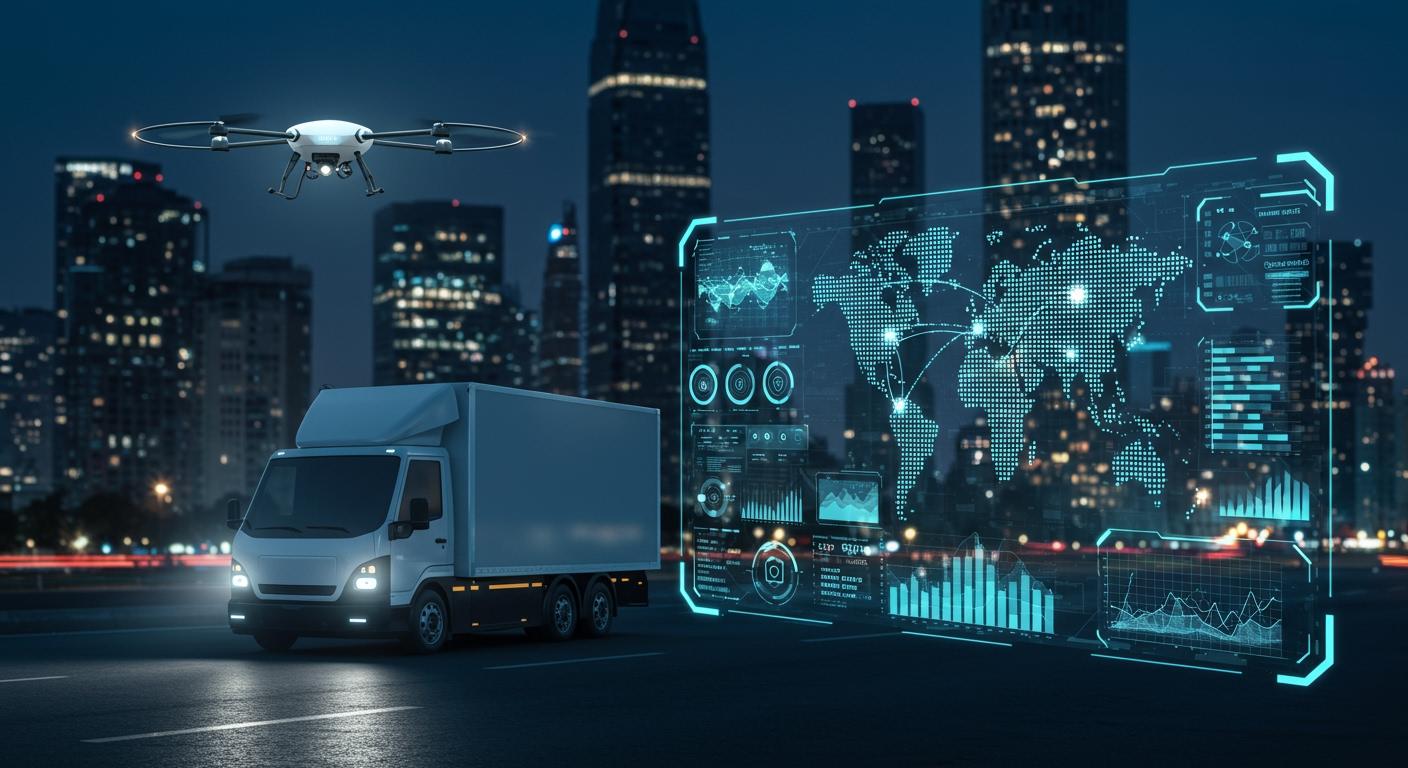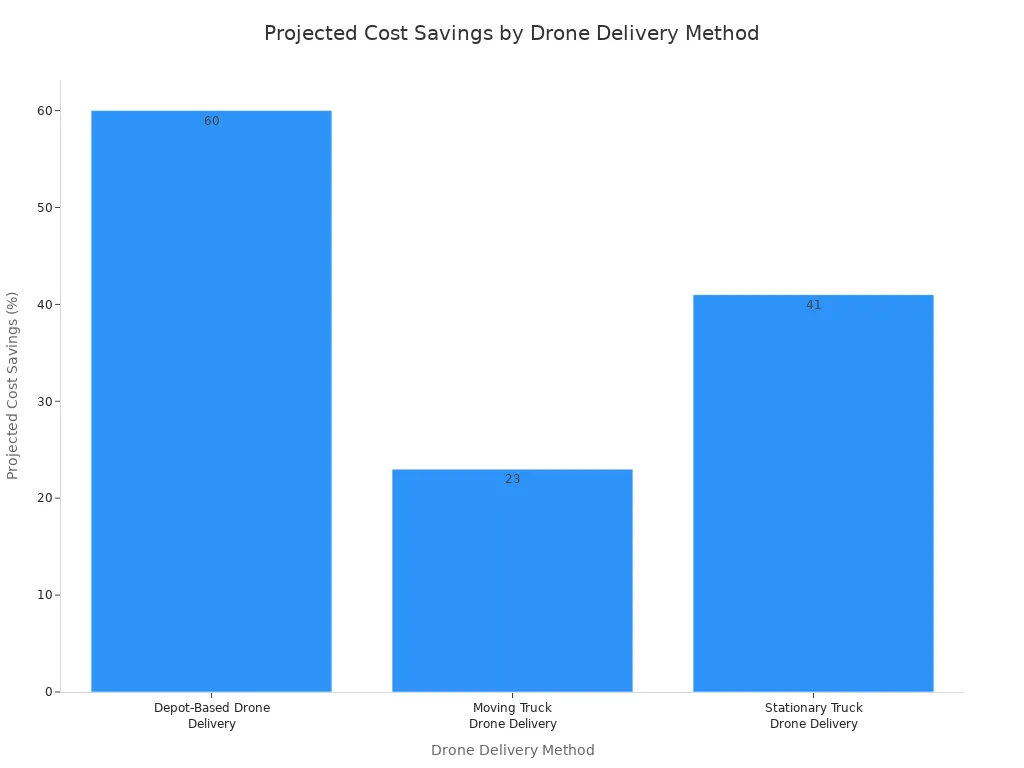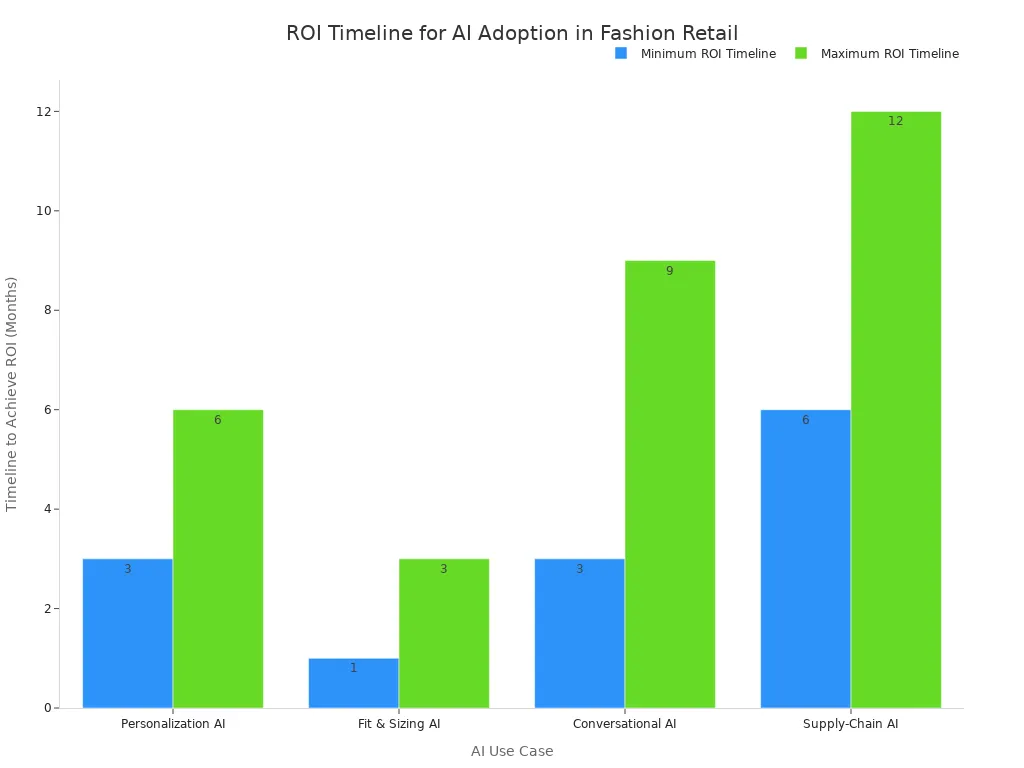
For fast fashion, 2025 marks a pivotal year. AI shifts just-in-time from reactive to predictive fulfillment. This evolution is a crucial move for cost reduction and efficiency. AI enables fashion retailers to anticipate demand. They can pre-position inventory before consumers even browse. This proactive approach to inventory and demand prediction makes operations faster. It also boosts productivity in online shopping. The growth of AI in the fashion industry is undeniable.
| Metric | Value |
|---|---|
| Projected Market Size (2025) | $1.75 billion |
| Compound Annual Growth Rate (CAGR) | 39.2% |
Mastering AI-enabled just-in-time delivery is the foundational strategy. Retailers use AI for better trend forecasting and product discovery. This helps them get to market faster. It provides a decisive competitive edge in the rapidly growing AI-driven fashion commerce market. AI helps predict purchase trends for a better shopping experience. AI is key to ai-enabled just-in-time delivery for fashion ecommerce. This AI-powered shopping is the future of fashion. AI makes the purchase and shopping process seamless for consumers.
Top AI Shopping Trends for 2025

The future of fashion commerce is proactive, not reactive. Key ai shopping trends for 2025 empower retailers to move beyond simple automation. They enable a predictive fulfillment model that anticipates consumer needs. This shift is central to building a resilient and efficient supply chain. The right AI applications turn data-driven insights into direct, automated actions that optimize the entire shopping journey.
Hyper-Personalized Forecasting
Predictive personalization is the new standard in trend forecasting. AI algorithms now analyze massive, diverse datasets in real time. These datasets include social media trends, local weather patterns, and real-time consumer behavior. This analysis allows fashion brands to predict demand at the individual product (SKU) level. The goal is to understand what consumers will want to purchase before they even search for it.
Leading companies already demonstrate the power of this approach.
- Levi's uses AI-powered demand forecasting. It integrates social media insights with sales data to create a responsive model for the fashion industry.
- Amazon employs deep learning to analyze external factors. This helps forecast demand for specific sizes and styles in different locations.
- Walmart analyzes weather forecasts with AI. This helps anticipate demand for seasonal items and uses social media sentiment to predict product trends.
This level of personalization creates better recommendations for consumers. It also drives smarter product development and more accurate inventory and demand prediction.
Autonomous Last-Mile Networks
The final step of the delivery process is often the most expensive and complex. Autonomous last-mile networks are changing this reality. Companies use self-driving vehicles and drones to deliver packages directly to consumers. This technology makes deliveries faster, cheaper, and more efficient. Leaders in this space are creating purpose-built solutions for retail and ecommerce.
- Nuro develops self-driving vehicles designed specifically for delivering goods.
- Starship Technologies operates a fleet of self-driving robots for local parcel and grocery delivery.
- Refraction AI builds autonomous robots that navigate urban environments for retail and grocery clients.
- JD.com operates a large fleet of driverless vehicles and drones in China.
The cost savings are significant. AI-powered autonomous delivery dramatically reduces the cost per package compared to traditional methods.
| Delivery Method | Cost per Delivery (Traditional) | Cost per Delivery (Drone) | Cost Savings |
|---|---|---|---|
| Depot-Based Drone Delivery | $2.2 | $0.9 | 60% |

This innovation is critical for ai-enabled just-in-time delivery. It ensures the final step of the purchase journey is as optimized as the first.
AI-Optimized Micro-Fulfillment
Micro-fulfillment centers (MFCs) are small, highly automated warehouses. They are placed in urban areas, close to where consumers live. This strategy shortens delivery routes, reduces shipping costs, and enables near-instant delivery for online shopping. AI is the brain that makes these facilities work. AI algorithms determine optimal MFC locations, decide which products to stock, and manage inventory flows based on local trends.
Orders are processed and sent to the last-mile courier, often in less than 30 minutes from when the consumer places the order.
Inside an MFC, AI and robotics work together.
- Robotic Picking Systems speed up order processing and reduce human error.
- AI-Driven Forecasting predicts local market demand to keep inventory balanced.
- Dynamic Slotting ensures high-demand fashion items are always accessible for quick picking.
Major retailers are already using this model. Walmart uses robotic MFCs to handle a majority of its digital grocery volume. Tesco has established Urban Fulfillment Centers in its UK stores to manage more orders efficiently. This approach helps fashion brands meet consumer expectations for speed and accuracy.
The Role of Generative AI
Generative AI offers more than just content creation and personalized recommendations. In logistics, it powers the creation of "digital twins." A digital twin is a virtual replica of a physical supply chain. Retailers use these simulations to model potential disruptions, test new strategies, and optimize workflows without any real-world risk. This allows for powerful "what-if" analysis to prepare for supplier issues or sudden demand spikes.
For example, CEVA Logistics used a digital twin for a fashion retailer's fulfillment center. The simulation helped them manage volatile fast fashion demand. It allowed planners to test new processes safely. This led to a significant increase in the center's weekly capacity.
This technology contributes to a self-repairing supply chain. The AI can anticipate problems and trigger corrective actions, like placing new purchase orders or reassigning resources with minimal human input. This capability extends to automated design and product discovery, where AI can generate and test new fashion concepts based on emerging trends. Generative AI provides the strategic foresight needed to master a truly predictive and resilient commerce operation.
Roadmap for AI-Enabled Just-in-Time Delivery

Transitioning to an AI-powered model requires a clear, step-by-step plan. Fashion retailers can follow a structured roadmap to automate workflows and optimize their supply chain. These foundational steps build the capacity for a truly predictive ai-enabled just-in-time delivery system. The journey begins with data, moves to intelligent platforms, and culminates in real-world testing.
Unified Data Integration
A successful AI strategy is built on a robust data infrastructure. AI models need high-quality data to generate accurate predictions and data-driven insights. Fashion brands must unify information from every corner of their business. This creates a single source of truth that fuels powerful AI. Key data sources include:
- Sales and operational data like Point of Sale (POS), purchase orders, and stock levels.
- Customer data from CRM databases, loyalty programs, and online shopping behavior.
- External signals such as social media activity, customer reviews, and demographic trends.
This comprehensive data pool allows AI to understand past performance and predict future shopping trends.
Predictive Analytics Platform Adoption
With a unified data foundation, retailers can adopt a predictive analytics platform. These platforms use AI to analyze complex datasets and deliver actionable consumer insights. For example, a platform like WovenInsights gives fashion brands real-time access to market trends and competitor performance. When selecting a platform, it is critical to ensure it can integrate with existing systems and scale with the business. The right platform transforms raw data into strategic recommendations for smarter product development and inventory management, helping fashion brands align with consumer purchase habits. This is essential for effective trend forecasting and automated design.
Piloting Fulfillment Automation
The final step is to test automation in a controlled environment. A pilot project validates the technology and builds team confidence before a full-scale rollout. It is best to start small and define clear goals. For example, a pilot could aim to reduce picking errors or increase shopping order throughput in a specific warehouse zone.
Tip: Don't automate existing inefficiencies. First, clean up inventory data and optimize current workflows. Then, introduce AI to enhance a stable process.
Success should be measured with specific KPIs, including Return on Investment (ROI), order accuracy, and average handling time reduction. This approach allows fashion brands to refine their ai-enabled just-in-time delivery strategy for ecommerce, ensuring the technology delivers tangible results for consumers and the commerce operation. The AI helps improve the entire purchase and shopping experience.
Overcoming Core AI Adoption Challenges
Adopting AI presents significant opportunities for the fashion industry. However, retailers must navigate several core challenges to succeed. Addressing these hurdles head-on is essential for building a resilient and intelligent supply chain. The main obstacles involve technology costs, data security, and system integration within ecommerce.
High Cost of Technology
The initial investment for AI technology can be substantial. Fashion brands often face high costs for software, hardware, and specialized talent. Many companies also struggle to remodel their business processes to incorporate AI effectively. However, the return on investment (ROI) can be surprisingly fast. Most successful AI projects in retail break even within 6 to 12 months.
The timeline for returns varies by the type of AI application. Supply-chain AI, which is crucial for just-in-time delivery, typically shows a positive ROI in 6 to 12 months. Other AI tools offer quicker wins.
| AI Use Case | ROI Timeline |
|---|---|
| Personalization AI | 3–6 months |
| Fit & Sizing AI | 1–3 months |
| Conversational AI | 3–9 months |
| Supply-Chain AI | 6–12 months |

This data shows that fashion brands can start with lower-cost AI projects to build momentum for larger supply chain transformations.
Data Privacy and Security
AI systems rely on vast amounts of data to generate personalized recommendations and predict shopping trends. This creates significant data privacy and security responsibilities for fashion retailers. Regulations like the GDPR in Europe and the CCPA in California impose strict rules on how companies collect and process personal data from consumers. Non-compliance can result in heavy fines and damage a brand's reputation.
To protect data, fashion companies should adopt several best practices:
- Anonymization: Remove personal identifiers from data used to train AI models.
- Federated Learning: Train AI models across multiple devices without centralizing raw data.
- Zero-Trust Architecture: Implement strict access controls, assuming every request could be a threat.
These measures help ensure that AI-driven personalization for online shopping respects consumer privacy and secures sensitive information.
Integration Challenges in Ecommerce
Integrating new AI platforms with existing ecommerce and ERP systems is a major technical hurdle. Many fashion businesses operate with data stored in separate silos, making it difficult for an AI to get a complete picture. Poor data quality can also lead to inaccurate AI predictions and weak product discovery. The technical complexity of AI tools often requires specialized knowledge that many teams lack.
Middleware and Application Programming Interfaces (APIs) act as bridges. They connect diverse software components for efficient collaboration.
Solutions like API gateways can create a central access point for AI in an organization. These tools help standardize data formats and automate connections between legacy systems and modern AI platforms. This allows the AI to analyze shopping trends and inform purchase decisions effectively. A smooth integration process is vital for any successful AI strategy in fashion ecommerce.
The 2025 fashion trends show AI is essential. Predictive AI, autonomous AI, and generative AI shape fashion shopping. Mastering this AI gives fashion a competitive edge. The AI fashion industry sees rapid AI adoption. AI enhances the fashion shopping experience. AI helps fashion brands understand shopping trends. This AI is vital for fashion shopping. AI improves fashion shopping. AI transforms fashion.
Begin by auditing your current data infrastructure. Identify one key area for an AI pilot project to stay ahead of the 2025 curve.
FAQ
How can small fashion brands start with AI?
Small fashion brands can begin with accessible ai tools. They should focus on one area, like inventory management. This approach allows the fashion business to see returns quickly. An ai pilot project provides valuable learning for the fashion company. The ai helps the fashion brand grow.
What is a digital twin in fashion logistics?
A digital twin is a virtual model of a supply chain. Fashion companies use this ai technology to run simulations. It helps predict problems and test solutions without real-world risk. This ai is crucial for building a resilient fashion supply chain. The ai models fashion operations.
Will AI replace jobs in the fashion industry?
AI will change jobs, not just eliminate them. The ai automates repetitive tasks. This allows employees to focus on strategic roles. The fashion industry needs workers to manage the ai systems. New roles in fashion will emerge to support ai integration and data analysis.
Why is data important for fashion AI?
High-quality data is the fuel for any ai system. An ai uses data to learn patterns and make predictions. In fashion, this helps forecast trends and manage stock. Without good data, the ai cannot provide accurate insights for the fashion business.
See Also
Revolutionary Tech Solutions Reshaping Shipping Logistics and Operations by 2025
Boosting Production Forecast Precision with AI: 2024 Enterprise Best Practices
Maximizing Operational Efficiency Through Pick-to-Cart Systems by the Year 2025
Key B2C Fulfillment Trends Accelerating Customer Deliveries and Satisfaction
Optimizing Retail Inventory Restocking Using Predictive Analytics by 2025